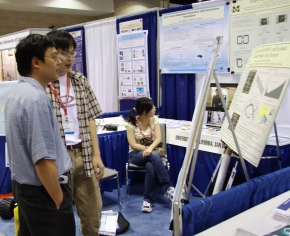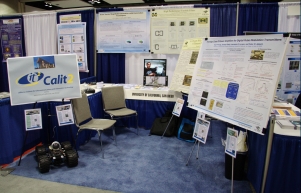The University of California Sweeps RFIC Student Paper Awards at IMS 2007
June 15, 2007 / By Maureen Curran
|
San Diego, CA and Honolulu, HI, June 15, 2007 -- Engineering graduate students from three University of California campuses -- Berkeley, Davis and San Diego -- won first, second and third places respectively for the best student papers in the Radio Frequency Integrated Circuits (RFIC) portion of the prestigious 2007 IEEE MTT-S International Microwave Symposium (IMS 2007) held in Honolulu, HI, last week, June 3-8, 2007.
"This is the premier conference on microwaves and radio frequency in the world," said Gabriel Rebeiz, professor of electrical and computer engineering (ECE) at the Jacobs School of Engineering.
"And it is one of the biggest in the IEEE," pointed out fellow ECE professor Larry Larson, "The IEEE Microwave and Techniques Society alone has over 9000 members." Three IEEE professional societies were represented at IMS 2007: the Radio Frequency Integrated Circuit Group, the Microwave Theory and Techniques Society (MTT) and the Automatic RF Techniques Group (ARFTG), which is involved with microwave instrumentation and measurements.
|
"If you are doing something in the range from about 800MHz to 80GHz," explained Calit2 principal development engineer Don Kimball, "this is the conference where all the interesting stuff is going on."
"One of our doctoral students - Yiping Han - won third place in the best student RFIC paper contest, out of more than 100 entries," noted Han's advisor Larson. The paper presented a 5.2GHz CMOS Transceiver test setup. It is one of the smallest transceiver chips ever reported. The results demonstrated that a high performance, low power, sub-mm2 transceiver is achievable in a deep submicrometer CMOS process.
This work is building towards the next generation of chips, "where multimedia, GPS, data and the internet can all be integrated together," Han explained, "Where everything in computers now can be put into a telephone."
"We are very happy and proud to have won third place," said Han, "I am also happy for the entire UC system. The sweep of the awards reflects the fact that California is the center of integrated circuits." Han will receive his ECE Ph.D. in a few months, after which he will be going to work at QUALCOMM. The UCSD division of Calit2, a UC Discovery Grant and Conexant sponsored the work.
Roughly a dozen papers from UCSD were presented this year from the research groups of Rebeiz, Larson and Peter Asbeck, also an ECE professor. Larson and Rebeiz gave six workshop presentations at the conference. A large contingent of UCSD researchers from the three labs attended the symposia, including Rebeiz's entire group, which included 16 graduate students and post-doctoral fellows, and four graduate students each from Asbeck's and Larson's labs.
Asbeck was unable to attend, but made note of two papers presented from his group: "Tsai-Pi Hung and Jeremy Rode have devised an innovative approach to microwave transmitters that integrates a lot of circuitry on a digital CMOS chip. This approach will become more and more attractive as Moore's Law advances and the dimensions of the CMOS transistors continue to shrink. Adam Conway has put together a simple model that describes complex phenomena that have been plaguing the GaN transistor community."
|
Joe Jamp from the Larson research group presented a paper entitled "A 10GS/s 5-bit Ultra-low Power DAC for Ultra-Wideband Spectral Encoded Transmitters." "The talk went smoothly," said Jamp, "After the session ended, I had a chat with people who were interested in my work, which was quite nice." Jamp just received his doctorate from UCSD in April.
Jason May, a grad student in Rebeiz's research group found the conference "a very enjoyable and useful experience. I saw many presentations that were directly related to my current research, which helped generate ideas for improving my future work. It was also a great networking opportunity - I met many prominent people in my field, either in industry or from other universities."
"In addition to the technical programs, this conference also has the largest industrial show in the world," said Rebeiz, "and UCSD had a well represented booth in it, coordinated by Don Kimball of Calit2." The trade show has the largest collection of microwave vendors at any conference in the U.S., all the military and civilian players participate.
Jamp worked in the UCSD Exhibition booth, "It was interesting, because apparently many people are well-aware of UCSD, its professors and the work that is being done." In all, 13 grad students rotated hosting the booth: Rahul Kodkani, Pavel Kolinko, Han and Jamp from Larson's lab; Adam Conway, Paul Draxler, Tsai-Pi Hung and Jeremy Rode from Asbeck's lab; and May, Berke Cetinoneri, Yusuf Atesal, Ramadan Al-Halabi and Tiku Yu from Rebeiz's group.
"The Exhibition is a great place for our students to learn about the latest RF/Microwave instrumentation," said Rebeiz, "and to see actual products (how they are assembled, how they are used, etc.)."
The UCSD Exhibition booth provided a showcase for Calit2 technology. "We set up the booth with Calit2 technology out front," explained Kimball, "We have this nice spectrum of mesh network technology: CalMesh, Urban Mesh and Calnode. The Gizmo truck with its four-wheel steering was a good draw because people would come by and ask 'What are you guys doing?'." Gizmo is a remote-controlled wireless node built and integrated into a toy monster truck. Four student posters each covering a major piece of a wireless communication system were also packed into the busy booth.
Also on display were the WIISARD blood pulse oximeter and patient tag, Calradio (a development platform) and a looping DVD of additional technologies and devices from the Circuits Lab at Calit2, which Kimball heads. More than 200 pounds of devices, inventions, tools, batteries, cables, power cords, handouts, and etc. were shipped to Honolulu.
|
"My gig is envelope tracking of high-power amplifiers," said Calit2's Kimball, "we set an efficiency record in 2005, which is still standing. As I attended sessions, I found that when they talk about the part that actually tracks the envelope, they have to reference our paper because they don't have one of their own. UCSD Calit2 not only has one, but has one that works. It makes you feel really good when other researchers who are doing some fine work point back to us."
Kimball continued: "While we are the only ones with a good end-to-end solution, I really wish two or three people would put all the pieces together, knew how to do it, so that the idea is not orphan. Then we could compare and contrast. It will happen when one of our students goes on to another university and says 'I can show you how to do this.'"
Related Links
2007 IEEE MTT-S International Microwave Symposium (IMS 2007)
High Speed Devices Group (Peter Asbeck)
Radio Frequency Integrated Circuit Research (Larry Larson)
Gabriel Rebeiz webpage




.jpg)

